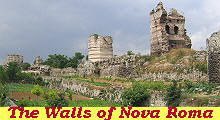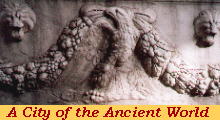

What's New!
Detailed Sitemap
All images © by Roberto Piperno, owner of the domain. Write to romapip@quipo.it. Text edited by Rosamie Moore.
Page added in September 2003.
|

 Byzantine Fortresses in the Empire of Trebizond Byzantine Fortresses in the Empire of Trebizond
(Emperor Constantine VI in a fresco at Sumela)
Introduction
The Empire of Trebizond stretched for hundred of miles along the coast of the Black Sea and it included
several ports which were founded by the first settlers who explored this sea. A series of little fortresses protected
these ports from pirate raids and most often from threats coming from the Anatolian tablelands.
The fortresses are usually of a rather small size, sometimes more a fortified watching post than a location
which could resist an assault and host a large garrison.
Unye
The little port of Unye is linked by a road to the town of Niksar (Neocesarea) in the tableland. To protect
Unye from threats coming from that road a little fortress was built to early detect and possibly stop the enemy.
View of the fortress and Roman tomb
The fortress is located at the top of an isolated rock at the center of a valley. The ruins, the thick vegetation,
the opening of an ancient Roman tomb all contribute to create a very "gothic" atmosphere of mystery. Tombs of this kind are very common in Lycia from Kaunos to Myra.
Main gate and secret exit
While most of the fortress is ruined, the entrance protected by round towers has been restored. The Byzantines
excavated the rock in order to have an alternative exit through which to flee the fortress or to attempt a sally.
Giresun
Today's Giresun is the Greek Kerazon and the Roman Cerasus. When the
Romans conquered it in 69 BC they "discovered" a new fruit which they brought home and to which they gave the name of the
town, which it still retains. English cherry, French cerise, Neapolitan cerasa all come from the same root.
The castle of Giresun and the town symbols
A high hill projecting into the sea was a perfect site for building the Acropolis of a Greek town. Over time
the Acropolis became a fortress of which a few walls still exist. Today the area of the castle is a preferred picnic site: I noticed
there the symbol of Giresun, which is not just based on the cherry, but also on the hazel-nut as the district is the largest
producer of hazel-nuts in Turkey, which in turn is a supplier to the European manufacturers of a well known spreading
paste based on them.
When the Black Sea is black and Giresun Island
Why the Black Sea is called black is a question which has several answers. According to some
experts, its name comes from the sulphurated hydrogen that blackens all metal objects
dropped to the ocean floor. A variation of this explanation makes reference to the fact that due to scarce
oxygenation its deeper waters are toxic. Most likely the Turks called it black in the sense of inhospitable, the same
impression the Greeks had at first, although, after having settled there, they changed their mind and called it
hospitable (Euxinos). As a matter of fact its waters may turn black more often than those of the Mediterranean Sea because
the southern (Anatolian) coast of this sea is very often covered by clouds and subject to frequent rains. At least
this is my conclusion based on the picture above.
Another aspect of the Black Sea which appeared unusual to the first Greek settlers was its total lack of islands. So
the Greeks appreciated very much finding this small islet (totally irrelevant from an Aegean Sea standard) near Giresun
and they hastened to build a temple there to Mars. Still today the leaflets on Giresun add to its beauties the fact
that this is the only island of the Black Sea.
Tirebolu
Saint Jean Castle in Tirebolu
Tirebolu is a little port between Giresun and Trebizond. The harbour is protected by an apparently imposing, but actually
rather small fortress, where you can go and sip a tea. Ruins of similar fortresses located on the sea can be found before
reaching Trebizond.
Andoz Castle
A few miles off Tirebolu, near the town of Espiye, there is a castle protecting the coast from attacks coming from the tableland.
Apart from the walls little else žs left of the old Byzantine fortress.
Surmene
The purported castle of Surmene
Based on information I found on a map of Eastern Turkey I expected the town of Surmene, east of Trebizond, to have
the ruins of a fortress. The taxi-driver whom I asked about it, led me to see this rock on a hill overlooking the coast.
I did not see apparent evidence of ruins, but I did not climb on it to make sure there were not.
So either a) Surmene has no ruins of fortresses, but due to his hospitality feelings the
taxi-driver felt obliged to show me the ruins of a fortress; or b) Surmene has somewhere ruins of a fortress, but my taxi-driver thought better not to go too far and he preferred to get the agreed fee without
spending too much time; or c) this is what is left of the fortress of Surmene.
P. S.: in May 2005 boralioglu@gmail.com a student from Surmene wrote me confirming that there is not a proper castle in the area, but that on top of the rock there are some ruins of walls and signs of a
well, so that it is likely it was used to protect the road leading to the town.

Move to:
Trebizond
Sumela Monastery
Clickable Map of Turkey showing all the locations covered in this website (opens in another window).

SEE THESE OTHER EXHIBITIONS (for a full list see my detailed list).
  
|